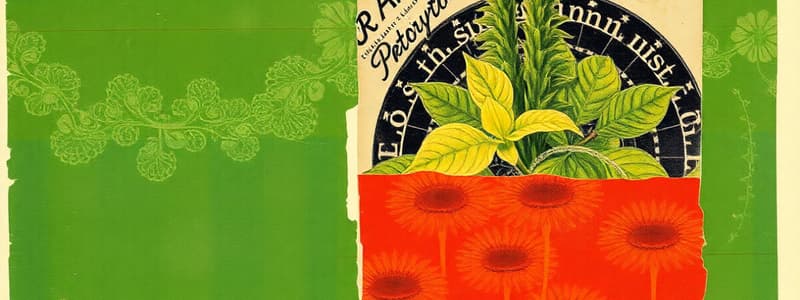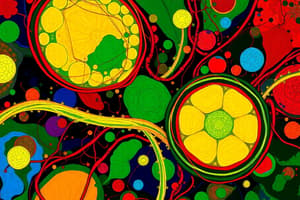Podcast
Questions and Answers
Where does the energy that drives photosynthesis originate?
Where does the energy that drives photosynthesis originate?
- Light absorbed by pigments in the chloroplast. (correct)
- The splitting of glucose molecules.
- Water absorbed by the plant's roots.
- Carbon dioxide that enters the leaf through the stomata.
Why do leaves appear green to the unaided human eye?
Why do leaves appear green to the unaided human eye?
- They transmit most of the green light wavelengths.
- They reflect most of the green light wavelengths. (correct)
- They absorb most of the green light wavelengths.
- They convert all wavelengths to green light.
What is the role of accessory pigments in photosynthesis?
What is the role of accessory pigments in photosynthesis?
- To protect the plant from absorbing too much light.
- To directly convert carbon dioxide into sugars.
- To absorb light wavelengths not captured by chlorophyll. (correct)
- To facilitate the movement of water in the plant.
In the light-dependent reactions of photosynthesis, what directly occurs after a photon strikes a pigment molecule?
In the light-dependent reactions of photosynthesis, what directly occurs after a photon strikes a pigment molecule?
What is the function of the reaction center in a photosystem?
What is the function of the reaction center in a photosystem?
What is the primary product formed during the light reactions of photosynthesis?
What is the primary product formed during the light reactions of photosynthesis?
Why does the cyclic electron flow pathway exist in photosynthesis?
Why does the cyclic electron flow pathway exist in photosynthesis?
What are the two photosystems found in chloroplasts?
What are the two photosystems found in chloroplasts?
What is the primary function of the cuticle layer on a leaf?
What is the primary function of the cuticle layer on a leaf?
Which of the following best describes the role of guard cells?
Which of the following best describes the role of guard cells?
What is the function of the vascular bundle in a leaf?
What is the function of the vascular bundle in a leaf?
What is the primary reason that stomata are generally open during the day?
What is the primary reason that stomata are generally open during the day?
Which of the following accurately represents the general equation for photosynthesis?
Which of the following accurately represents the general equation for photosynthesis?
The influx of which ion into the guard cells causes them to become turgid, thus opening the stoma?
The influx of which ion into the guard cells causes them to become turgid, thus opening the stoma?
What is the term for organisms that can produce their own food through processes like photosynthesis?
What is the term for organisms that can produce their own food through processes like photosynthesis?
Where within a plant cell does photosynthesis primarily take place?
Where within a plant cell does photosynthesis primarily take place?
Flashcards
What is photosynthesis?
What is photosynthesis?
The process by which plants use light energy, carbon dioxide, and water to produce glucose (a sugar) and oxygen.
What are autotrophs?
What are autotrophs?
Organisms that can create their own food through photosynthesis. They form the base of the food chain.
What are heterotrophs?
What are heterotrophs?
Organisms that rely on consuming other organisms for food and energy. They depend on autotrophs for survival.
Where does photosynthesis occur?
Where does photosynthesis occur?
Signup and view all the flashcards
What are stomata?
What are stomata?
Signup and view all the flashcards
What are guard cells?
What are guard cells?
Signup and view all the flashcards
What is xylem?
What is xylem?
Signup and view all the flashcards
What is phloem?
What is phloem?
Signup and view all the flashcards
Light Reactions
Light Reactions
Signup and view all the flashcards
Photosystem
Photosystem
Signup and view all the flashcards
Photosystem I (PSI)
Photosystem I (PSI)
Signup and view all the flashcards
Photosystem II (PSII)
Photosystem II (PSII)
Signup and view all the flashcards
Pigment
Pigment
Signup and view all the flashcards
Visible Spectrum
Visible Spectrum
Signup and view all the flashcards
Photoexcitation
Photoexcitation
Signup and view all the flashcards
Thylakoid
Thylakoid
Signup and view all the flashcards
Study Notes
Photosynthesis Overview
- Photosynthesis converts light energy, carbon dioxide, and water into high-energy compounds like glucose.
- The general equation for photosynthesis is: 6CO₂ + 6H₂O + light energy → C₆H₁₂O₆ + 6O₂.
- Photosynthesis is essentially the reverse of cellular respiration.
- Autotrophs, like plants and algae, perform photosynthesis to create their own food.
- Without autotrophs, heterotrophs (organisms that eat other organisms) would not have a food/energy source.
- Photosynthesis happens in the chloroplast.
Chloroplast Structure
- Chloroplasts contain internal membranes called thylakoid membranes, organized into stacks called grana.
- The fluid-filled space around the thylakoids is called the stroma.
- Chloroplasts contain two main membranes: outer and inner.
- The chloroplast contains chlorophyll, which traps light energy.
Chlorophyll and Pigments
- Chlorophyll primarily absorbs red and blue light wavelengths, reflecting green light, causing leaves to appear green.
- Other pigments, like carotenoids and xanthophylls, absorb different wavelengths, contributing to colors like yellow and orange.
- These accessory pigments absorb colors that chlorophyll doesn't absorb for more efficient light capture.
- Pigments are molecules that absorb light; their color depends on the light they reflect.
Parts of a Leaf and their Functions
- Cuticle: Protective waxy layer on the leaf surface.
- Epidermis: Transparent layer of cells below the cuticle.
- Mesophyll: Cells forming the bulk of the leaf; contains chloroplasts.
- Vascular Bundle (Vein): Transports water and nutrients, including sugars.
- Guard Cells: Regulate the opening and closing of stomata (pores) to control gas exchange.
- Stoma: Pores on the leaf surface where gases (carbon dioxide, oxygen) exchange between the leaf and atmosphere.
Photosynthesis Raw Materials
- Light: Enters leaves through the upper epidermis and is absorbed by chlorophyll in the mesophyll.
- Water: Taken up by roots and transported to leaves through vascular bundles.
- Carbon Dioxide: Enters leaves through stomata.
Photosystem
- A photosystem is a protein complex in the thylakoid membrane containing pigments (e.g., chlorophyll) that capture light.
- These pigments capture light energy, exciting electrons that are passed along to power photosynthesis.
- Photosystems I and II are the primary photosystems.
Cyclic and Noncyclic Photophosphorylation
- Both are processes in the light-dependent reactions that generate ATP.
- Noncyclic photophosphorylation creates ATP and NADPH, producing oxygen (O2).
- Cyclic photophosphorylation creates ATP without producing NADPH or oxygen.
Calvin Cycle
- The Calvin cycle uses ATP and NADPH from light-dependent reactions to fix carbon dioxide into carbohydrates (sugars).
- The Calvin cycle occurs in the stroma of the chloroplast.
- The Calvin cycle is also known as the light-independent reactions.
Studying That Suits You
Use AI to generate personalized quizzes and flashcards to suit your learning preferences.




